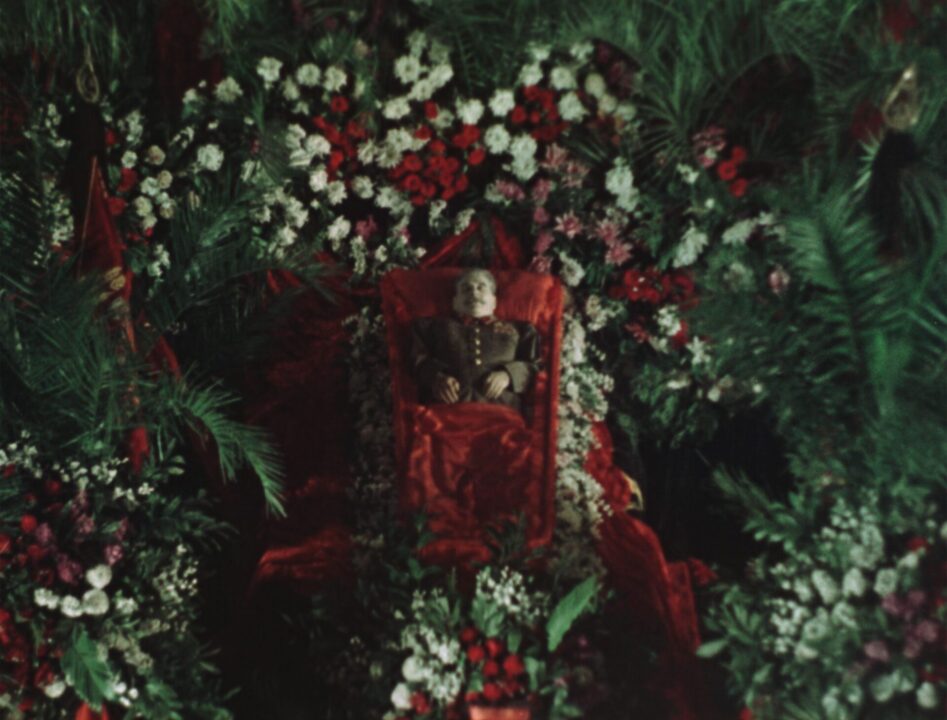If a country were to put its entire national identity into a government ruled by one political party, and if that one political party were to put its entire identity into one person–and if that person were to then die, leaving a vacuum of identity and direction in his wake–what would that look like? The answer can be seen in the new documentary State Funeral. At over two hours long and comprised entirely of restored footage shot over those historic days, the film captures the grandly-staged spectacles in which the Soviet Union mourned and serves as an unsettling depiction of how Totalitarian savior politics affects its citizens.
Expression
State Funeral relies on the emotions emitted from the faces of the people who fill the screen as they learn the news of Stalin’s death on March 5th, 1953 (he passed away of a brain hemorrhage due to hyper-tension). What’s fascinating is that all of the people–young, old, men, women, army members, citizens and workers alike–collectively mourn in the same solemn and stoic way; nearly expressionless, with the occasional breaking of tears. It’s exactly what you would expect though, from a Communist nation whose political philosophy rested on a projected sense of emotional strength. Because of this, State Funeral is a mostly introspective experience that requires the viewer to look past these stone-walled faces and wonder what the uncertain and fearful thoughts are running through their minds throughout their mourning.
Expression: 3 out of 5 stars
Daring
State Funeral is daring in its form for the fact that it is composed entirely of assembled footage and without a “narrative,” so to speak. For that reason it really is as much of an arthouse film as one could expect. What’s more is that the footage and sequences play in long stretches, leaving lots of times to process the footage and feeling (it’s a lot to ask of an unseasoned viewer, who, if they choose to stream the film digitally, might choose to watch it in stretches). So while cutting down on shot lengths and even using voice-over narration would certainly make the film more accessible, director Sergey Loznitsa presents the historical footage as objectively as possible to allow the audience to make up their own minds without over-influencing the events.
Expression: 3 out of 5 stars
Craft
The first thing you’ll notice while watching is that all of this historical footage is pristinely restored and colored which makes for a photographic journey that transports you back in time. Alternating between black and white and colored footage, this fluid visual change-up is also welcomed for how it breaks up the viewing (which could otherwise feel repetitive due to the similarity in the footage that’s presented). The film also uses silence to great effect, which feels eerie seeing lined-blocks and fully-filled town squares with large crowds totally quiet.
And then there’s the film’s editing: although it has no narrative, there is a naturally assembled arc that grows from the smaller pockets of villages that scales to the larger masses, whose scale of people mourning, whose scale looms large and proves powerful.
Craft: 3 out of 5 stars
Impact
Seeing the scope of the mourning is impactful in and of itself. Masses of crowds in the tens of thousands, drawings and tributes, and around 900,000 wreaths (okay maybe not that many, but there’s certainly a ton), is all wild to see. It’s also impactful to see how people mourn amongst the state-sponsored messages that are so present, which makes you realize as a viewer that you need to reframe from this trance and objectively witness the events in front of you: tens of thousands of people whose grief is manipulated through propaganda.
The film also allows the viewer to meditate on what a state-sponsored funeral would look like under Totalitarian rule (which, in recent American and world politics, makes one curious where those roads could lead). It’s also impactful in that it offers a meditation on what it might be like to be a part of a directionless citizen body, knowing that every single person is consumed by the same unrest.
Impact: 4 out of 5 stars
Conclusion
State Funeral is a true cinematic treasure, and its existence stands as a landmark artifact for historians and cinephiles alike to see what the death of a leader under Totalitarian regime looks like. Its overall impact will rely on how much you’re willing to extrapolate from it: if you’re simply looking at the stunning images themselves, you’ll certainly be impressed at what’s on screen. But if you dive deeper you’ll see the cinematic achievement for what it is, serving as a warning so that audiences can guard themselves from finding ourselves subjected to needing to attend something similar to it in the future.
Conclusion: 4 out of 5 stars
135 minutes. ‘State Funeral’ is available to stream on MUBI starting Friday, May 21.
Ryan Rojas
Ryan is the editorial manager of Cinemacy, which he co-runs with his older sister, Morgan. Ryan is a member of the Hollywood Critics Association. Ryan's favorite films include 2001: A Space Odyssey, The Social Network, and The Master.


